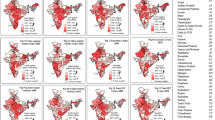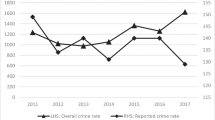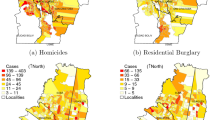Abstract
In the last years, the increasing level of criminality that has characterized the modern economies has drawn the attention of sociologists and economists in order to identify the causes leading to commit criminal offences. The aim of the paper is to investigate the causes of crime activity in 103 Italian provinces (NUTS3 regions) for the years 1999 and 2003. The Italian crime phenomenon is characterized by some stylized facts: high spatial and time variability of crime activities, and presence of ‘organized crime’ (e.g. Mafia and Camorra) localized in some local territorial areas.
Using exploratory spatial data analysis (ESDA), the paper firstly explores the spatial structure and distribution of four different typologies of crimes: murders, thefts, frauds and squeezes. ESDA allows us to detect some important geographical dimensions and to distinguish crucial micro- and macro- territorial aspects of offences. Further, on the basis of Becker-Ehrlich model, a spatial cross-sectional model – including deterrence, economic and socio-demographic variables – has been performed to investigate the determinants of Italian crime in 1999 and 2003 and its ‘neighbouring’ effects, measured in terms of ‘geographical’ and ‘relational’ proximities.
The empirical results obtained by using different spatial weights matrices highlighted that socio-economic variables have a relevant impact on crime activities, but their role changes enormously respect to crimes against person (murders) or against property (thefts, frauds and squeezes) and over time.
Zusammenfassung
In den letzten Jahren hat die zunehmende Kriminalitätsrate der modernen Volkswirtschaften die Aufmerksamkeit der Soziologen und Ökonomen auf sich gezogen um die Ursachen zu ermitteln, die dazu führen diese Straftaten zu begehen. Das Ziel dieser Studie ist die Ursachen der Kriminellen Aktivitäten in 103 italienischen Provinzen für die Jahre 1999 und 2003 zu ermitteln. Dieses Phänomen zeichnet sich durch einige stilisierte Fakten: hohe räumliche und zeitliche Veränderlichkeit von kriminellen Aktivitäten und die Präsenz von “organisiertem Verbrechen” (z. B. Mafia und Camorra) örtlich in regionalen Gebieten eingegrenzt. Mittels der explanatory spatial data analysis (ESDA) untersucht die Studie zunächst die räumliche Struktur und Verteilung von vier verschiedenen Arten von Verbrechen: Mord, Diebstahl, Betrug und Erpressung.
ESDA ermöglicht es uns wichtige geographische Dimensionen zu ermitteln und bedeutende Mikro- und Makro-regionale Aspekte von Straftaten zu unterscheiden. Weiterhin, auf der Grundlage des Becker-Ehrlich Modells, wurde ein räumlicher Querschnitt-Modell erstellt, welches Abschreckungsvariabeln, wirtschaftliche und sozio-demographische Variablen miteinbezieht, um die Ursachen zu ermitteln, gemessen bezüglich der geographischen und relationalen Nähe, welche die italienische Kriminalität für die Jahre 1999 und 2003 und ihre “benachbarten” Auswirkungen prägen. Mittels der unterschiedlichen räumlich gewichteten Matrizen zeigen die Ergebnisse, dass die sozio-ökonomischen Variablen eine relevante Auswirkung auf die Kriminellen Aktivitäten haben, aber ihre Rolle sich erheblich ändert mit Bezug auf Verbrechen gegen die Person (Mord) oder gegen Eigentum (Diebstahl, Betrug und Erpressung).
Similar content being viewed by others
References
Akerlof GA (1997) Social distance and social decision. Econometrica 65:1005–1027
Anselin L (1988) Spatial econometrics: methods and models. Kluwer, Dordrecht
Anselin L (2002) Under the hood. Issues in the specification and in the interpretation of spatial regression model. Agr Econ 27:247–267
Anselin L, Bera A (1998) Spatial dependence in linear regression models with an application to spatial econometrics. In: Ullah A, Giles DEA (eds) Handbook of applied economic statistics. M. Dekker, New York, pp 255–258
Anselin L, Bera AH, Florax R, Yoon MJ (1996) Simple diagnostic test for spatial dependence. Reg Sci Urban Econ 26:77–104
Anselin L, Cohen J, Cook D, Gorr W, Tita G (2000) Spatial analyses of crime. In: Duffee D (ed) Criminal Justice 2000, vol 4. Measurement and Analysis of Crime and Justice. National Institute of Justice, Washington, pp 213–262
Becker GS (1968) Crime and punishment: an economic approach. J Polit Econ 76:169–217
Buonanno P (2006) Crime and labour market opportunities in Italy (1993–2002). Labour 20:601–624
Buonanno P, Leonida L (2006) Education and crime: evidence from Italian regions. Appl Econ Lett 31:709–713
Burdett K, Lagos R, Wright R (2004) An on-the-job search model of crime, inequality, and unemployment. Int Econ Rev 45:681–706
Cezay AK, Braithwaite J, Chapman B (1998) Unemployment and crime: toward resolving the paradox. J Quant Criminol 14:215–243
Cherry TL, List JA (2002) Aggregation bias in the economic model of crime. Econ Lett 75:81–86
Dietz RD (2002) The estimation of neighbourhood effects in the social sciences: an interdisciplinary approach. Soc Sci Res 31:539–575
Edmark K (2005) Unemployment and crime: is there a connection? Scand J Econ 107:353–373
Ehrlich I (1973) Participation in illegitimate activities: a theoretical and empirical investigation. J Polit Econ 81:521–565
Entorf H, Spengler H (2000) Socioeconomic and demographic factors of crime in Germany. Evidence from panel data of the German states. Int Rev Law Econ 20:75–106
Eronen M, Hakola P, Tiihonen J (1996) Factors associated with homicide recidivism in a 13-year sample of homicide offenders in Finland. Psychiat Serv 47:403–406
Florax RJGM, Folmer H, Rey SJ (2003) Specification searchers in spatial econometrics: the relevance of Hendry’s methodology. Reg Sci Urban Econ 33:557–579
Glaeser EL, Sacerdote B, Scheinkman JA (1996) Crime and social interactions. Q J Econ 111:507–548
Homant RJ (1984) Employment of ex-offenders: the role of prisonization and self-esteem. J Offender Couns Serv Rehabil 8:5–23
Hsieh CC, Pugh MD (1993) Poverty, income inequality, and violent crime: a meta-analysis of recent aggregate data studies. Crime Justice 18:182–202
Huang CC, Laing D, Wang P (2004) Crime and poverty: a search-theoretic approach. Int Econ Rev 45:900–938
Ichiro K, Kennedy BP, Wilkinson RG (1999) Crime: social disorganization and relative deprivation. Soc Sci Med 48:719–731
ISTAT (1998) Statistiche Territoriali. http://www.istat.it Accessed 10 May 2007
ISTAT (1999a) Statistiche Giudiziarie. http://www.istat.it. Accessed 10 May 2007
ISTAT (1999b) Statistiche Demografiche. http://www.istat.it. Accessed 10 May 2007
ISTAT (1999c) Indagine Trimestrale sulle Forze Lavoro. http://www.istat.it. Accessed 10 May 2007
ISTAT (1999d) Dati di Contabilit‘a Nazionale. http://www.istat.it. Accessed 10 May 2007
ISTAT (2000) Statistiche Giudiziarie. http://www.istat.it. Accessed 10 May 2007
ISTAT (2002) Statistiche Territoriali. http://www.istat.it. Accessed 10 May 2007
ISTAT (2003a) Statistiche Giudiziarie. http://www.istat.it. Accessed 10 May 2007
ISTAT (2003b) Statistiche Demografiche. http://www.istat.it. Accessed 10 May 2007
ISTAT (2003c) Indagine Trimestrale sulle Forze Lavoro. http://www.istat.it. Accessed 10 May 2007
ISTAT (2003d) Dati di Contabilit‘a Nazionale. http://www.istat.it. Accessed 10 May 2007
ISTAT (2006) Statistiche Giudiziarie. http://www.istat.it. Accessed 10 May 2007
Leenders RTAJ (2002) Modelling social influence through network autocorrelation: constructing the weight matrix. Soc Networks 24:21–47
Lochner B (2004) Education, work, and crime: a human capital approach. Int Econ Rev 45:811–843
Luiz JH (2001) Temporal association, the dynamics of crime and their economic determinants: a time series econometric model of South Africa. Soc Indic Res 53:33–61
Maggioni MA, Nosvelli M, Uberti TE (2007) Space versus networks in the geography of innovation: a European analysis. Pap Reg Sci 86:471–493
Marselli R, Vannini M (1997) Estimating a crime equation in the presence of organized crime: evidence from Italy. Int Rev Law Econ 17:89–113
Marselli R, Vannini M (2000) Quanto incide la disoccupazione sui tassi di criminalit‘a?. Riv Polit Econ Ottobre-Novembre:273–299
Merlo A (2004) Introduction to economic models of crime. Int Econ Rev 45:677–679
Messner SF, Anselin L, Baller RD, Hawkins DF, Deane G, Tolnay SE (1999) The spatial pattering of county homicide rates: an application of explanatory spatial data analysis. J Quant Criminol 15:423–450
Orsagh T, Chen JR (1988) The effect of time served on recidivism: an interdisciplinary theory. J Quant Criminol 4:155–171
Stigler GJ (1970) The optimum enforcement of laws. J Polit Econ 78:526–536
Author information
Authors and Affiliations
Corresponding author
Additional information
JEL classification
C21, K40
Rights and permissions
About this article
Cite this article
Cracolici, M.F., Uberti, T.E. Geographical distribution of crime in Italian provinces: a spatial econometric analysis . Jahrb Regionalwiss 29, 1–28 (2009). https://doi.org/10.1007/s10037-008-0031-1
Accepted:
Published:
Issue Date:
DOI: https://doi.org/10.1007/s10037-008-0031-1




